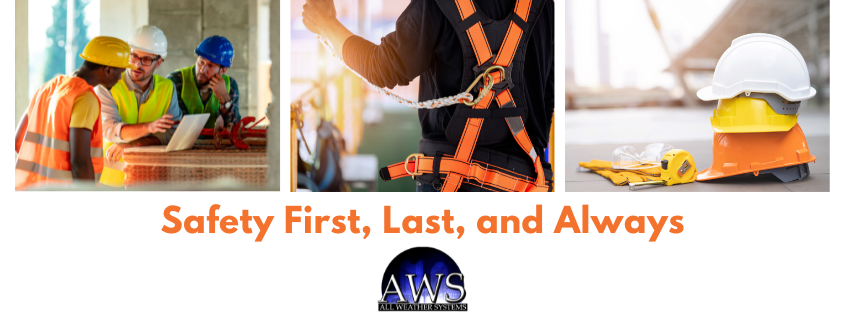At All Weather Systems, we believe a successful roof isn’t just about the materials or the installation – it’s about the safety of our team. Roofing can be a hazardous job, but by prioritizing safety practices, we can ensure everyone goes home healthy at the end of the day. Our motto “Safety first, last, and always” underlines our commitment to roofing safety. We not only aim to complete the job on time but also ensure that everyone gets home safely to their families. It’s not just about roofs—it’s about people.
Fall Protection: Our Lifeline
Falls are a leading cause of injury in the construction industry, and roofing is no exception. Here’s how we minimize fall risks:
- Fall Arrest Systems: OSHA regulations mandate the use of fall arrest systems whenever workers are at risk of falling six feet or more. This includes safety harnesses, lifelines, and secure anchor points. Regular inspections of harnesses and lifelines are crucial.
- Guardrails: When possible, we install guardrails along roof edges and around skylights to prevent falls altogether.
- Roof Pitch: On steeper inclines (greater than 4:12 pitch), a combination of fall arrest systems and walking/working surfaces like scaffold planks may be necessary.
Ladder Safety: The Foundation of Stability
Ladders are essential for roof access, but their misuse can lead to serious injuries. Here’s how we use ladders safely:
- Pre-Inspection: Inspect ladders before each use for cracks, loose rungs, or other damage. Never use a faulty ladder.
- Proper Placement: Place the ladder on stable, level ground and secure it at the top and bottom to prevent slipping. The base of the ladder should be positioned one foot out from the wall for every four feet of ladder height.
- Three Points of Contact: Maintain three points of contact with the ladder at all times (two hands and a foot, or two feet and a hand) when climbing or descending.
- Tool Carrying: Use a hoist or bucket to raise tools and materials – never carry them in your hands while climbing a ladder.
Personal Protective Equipment (PPE): Your Shield
- Hard Hat: Protects your head from falling objects and debris.
- Safety Glasses: Shields your eyes from dust, flying debris, and particles.
- Gloves: Protects hands from cuts, punctures, and blisters.
- Work Boots: Provides proper traction to prevent slips and falls, with steel toes for added protection.
- Hi-Visibility Clothing: Wearing brightly colored vests or jackets with reflective stripes increases visibility, especially during low-light conditions.
Hazard Awareness and Mitigation
- Weather Conditions: Avoid working on roofs during high winds, rain, or extreme temperatures. These conditions can increase the risk of slips, falls, and heatstroke.
- Power Lines: Identify and mark any low-hanging power lines before starting work. Maintain a safe distance and use non-conductive tools when working near electricity.
- Roof Inspection: Before workers access the roof, conduct a thorough inspection to identify potential hazards like weak spots, damaged areas, or protruding objects.
- Housekeeping: Maintain a clean and organized work area. Regularly clear debris like nails, shingles, and tools to prevent tripping hazards.
- Communication is Key: Ensure clear communication between crew members to avoid misunderstandings and potential accidents.
Safety Training: An Ongoing Commitment
Roofing Safety training is an investment, not a cost. Regular training helps our roofers stay up-to-date on best practices, fall protection standards, and hazard identification. All Weather Systems is committed to providing ongoing safety training for our team to ensure everyone has the knowledge and skills to work safely and effectively.
Working Together for a Safe Workplace
By prioritizing safety practices, roofing contractors can create a work environment where everyone feels protected. At All Weather Systems, we believe that roofing safety is not just a priority – it’s a core value. If you’re looking for a roofing company that puts safety first, contact us today!
